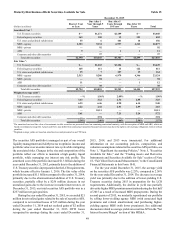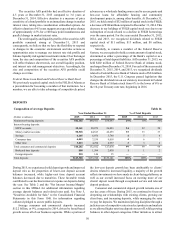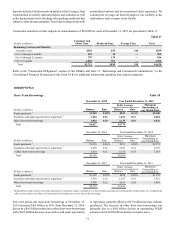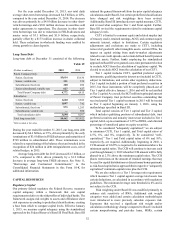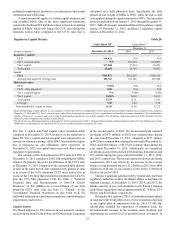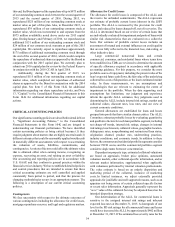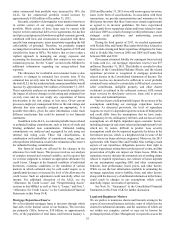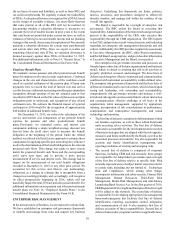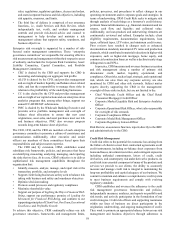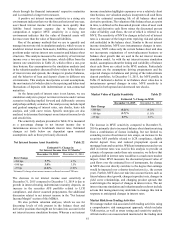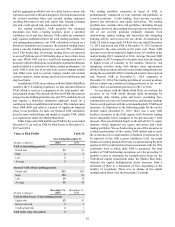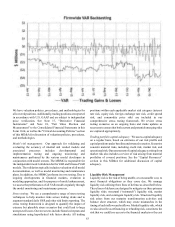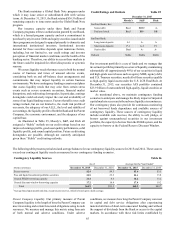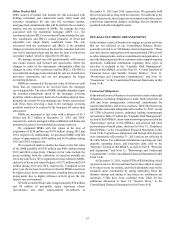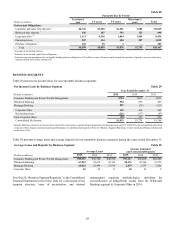SunTrust 2015 Annual Report Download - page 86
Download and view the complete annual report
Please find page 86 of the 2015 SunTrust annual report below. You can navigate through the pages in the report by either clicking on the pages listed below, or by using the keyword search tool below to find specific information within the annual report.58
the tax bases of assets and liabilities, as well as from NOL and
tax credit carryforwards. We regularly evaluate the realizability
of DTAs. A valuation allowance is recognized for a DTA if, based
on the weight of available evidence, it is more-likely-than-not
that some portion or all of the DTA will not be realized. In
determining whether a valuation allowance is necessary, we
consider the level of taxable income in prior years to the extent
that carrybacks are permitted under current tax laws, as well as
estimates of future pre-tax and taxable income and tax planning
strategies that would, if necessary, be implemented. We currently
maintain a valuation allowance for certain state carryforwards
and certain other state DTAs. Since we expect to realize our
remaining federal and state DTAs, no valuation allowance is
deemed necessary against these DTAs at December 31, 2015.
For additional information, refer to Note 14, “Income Taxes,” to
the Consolidated Financial Statements in this Form 10-K.
Employee Benefit Plans
We maintain various pension and other postretirement benefit
plans for employees who meet certain requirements. Continued
changes in the size and characteristics of the workforce could
result in a partial settlement of the pension plan. If lump sum
payments were to exceed the total of interest cost and service
cost for the year, settlement accounting would require immediate
recognition through earnings of any net actuarial gain or loss
recorded in AOCI based on the fair value of plan assets and plan
obligations prior to settlement, and recognition of any related
settlement costs. We estimate the financial impact of a partial
settlement in 2016 would be the recognition of approximately
$40 million in additional benefit costs.
On December 31, 2015, we refined the calculation of the
service and interest cost components of net periodic benefit
expense for pension and other postretirement benefit
plans. Previously, we estimated service and interest cost
components utilizing a single weighted-average discount rate
derived from the yield curve used to measure the benefit
obligation at the beginning of the period. Under the refined
method, we utilized a full yield curve approach to estimate these
components by applying specific spot rates along the yield curve
used in the determination of the benefit obligation to the relevant
projected cash flows. This change was made to more closely
match the projected benefit cash flows and the corresponding
yield curve spot rates, and to provide a more precise
measurement of service and interest costs. This change had no
impact on the measurement of our total benefit obligations
recorded at December 31, 2015 or any other prior period. We
accounted for this service and interest cost methodology
refinement as a change in estimate that is inseparable from a
change in accounting principle, and, accordingly, will recognize
its effect prospectively beginning in 2016, which will not
materially impact the total 2016 net periodic pension benefit. For
additional information on our pension and other postretirement
benefit plans see Note 15, “Employee Benefit Plans,” to the
Consolidated Financial Statements in this Form 10-K.
ENTERPRISE RISK MANAGEMENT
In the normal course of business, we are exposed to various risks.
We have established an enterprise risk governance framework
to identify and manage these risks and support key business
objectives. Underlying this framework are limits, policies,
metrics, processes, and procedures designed to effectively
identify, monitor, and manage risk within the confines of our
overall risk appetite.
The Board is responsible for oversight of enterprise risk
governance. The BRC assists the Board in executing this
responsibility. Administration of the framework and governance
process is the responsibility of the CRO, who executes this
responsibility through the CRM organization. The CRO reports
to the CEO, and provides overall vision, direction, and leadership
regarding our enterprise risk management framework and risk
culture. Additionally, the CRO provides regular risk assessments
to Executive Management, the BRC, other Board committees,
and the full Board, as appropriate, and provides other information
to Executive Management and the Board, as requested.
Our enterprise risk governance structure and processes are
founded upon a three line of defense organizational and business
model, which is critical to ensuring that risk in all activities is
properly identified, assessed, and managed. The three lines of
defense model requires effective teamwork and communication,
combined with individual accountability within defined roles.
The enterprise risk governance framework and the three lines of
defense are foundational to our risk culture, which is based upon
strong risk leadership; risk ownership and accountability;
comprehensive risk governance structure and strategy; a well-
articulated risk appetite and associated limits; robust interaction
and communication; effective challenge at all levels of the
organization; talent management, supported by appropriate
training; incorporation of risk considerations in performance,
compensation, and consequence management; and sound
technology and reporting.
• The first line of defense is comprised of all teammates within
our business segments, as well as those within Functional
units executing select activities. The first line of defense
owns and is accountable for the development and execution
of business strategies that are aligned with the risk appetite,
measures, and limits established by the Board, as well as the
associated processes and controls. It is also responsible for
accurate and timely identification, management, and
reporting/escalation of existing and emerging risks.
• The second line of defense is comprised of corporate
functions, including CRM and risk stewards; these groups
are responsible for independent governance and oversight
of the first line of defense relative to specific risks. Risk
stewards represent areas of subject matter expertise relative
to certain risks, including, but not limited to: Technology
Risk and Compliance, which among other things,
encompasses information and cyber-security, Finance Risk
Management, Human Resources, Third-Party Risk
Management, Model Risk Management, and Anti-Money
Laundering/Bank Secrecy Act. In the first quarter of 2016,
FRB Regulation W Oversight and Enterprise Data Oversight
will be added as risk stewards. The second line of defense
is responsible for developing appropriate risk management
frameworks/programs that facilitate first line of defense
identification, reporting, assessment, control, mitigation,
and communication of risk. It also monitors first line of
defense execution of these responsibilities. Second line of
defense frameworks/ programs conform to applicable laws,



